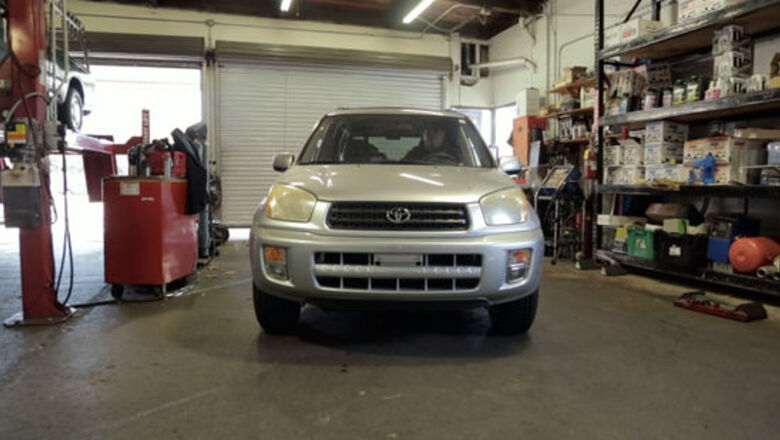
views
Elevating the Vehicle
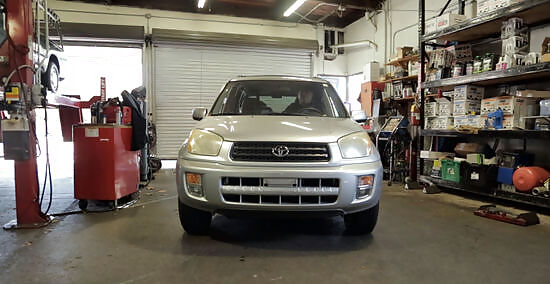
Park the car on a flat surface. Pull the car into a garage or park it on a level spot in your driveway. Make sure that the ground is level and that you have enough working area on all sides of the vehicle. Place the car in park, remove the keys and apply the parking brake. Leave the car idle for 5–10 minutes to let the oil cool down. If you neglect to let the car sit, you could scald yourself when you drain the oil.

Jack up the vehicle by placing your car jack beneath the jacking point. Situate your car jack beneath the chassis near the front of your car. Insert the square-shaped end of the metal crank into the square-shaped receptacle. Rotate the crank clockwise to jack up your car so its front is about 18 inches (46 cm) off of the ground. This will give you plenty of space to work underneath the car. If you are unsure of the location of the jacking point on your vehicle, check the owner’s manual for specifics.
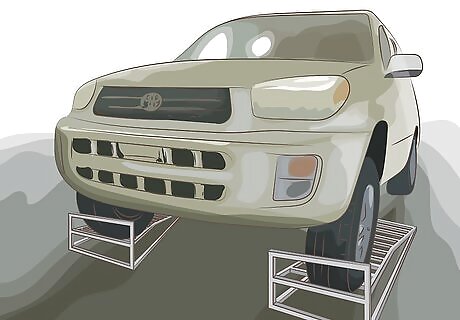
Drive your vehicle up onto steel ramps if you don’t have a jack. Some people prefer to use steel ramps (rather than a jack) when they’re changing their oil. Situate the 2 ramps as far apart as your vehicle’s wheels are. This is typically about 4 feet (1.2 m). Drive your vehicle forward until it’s at the top of the ramps. The wheels should sink down into depressions at the top of the ramps which will hold the vehicle in place, Ramps give you 2 points of suspension on your vehicle rather than just 1. They’re commonly used in mechanics’ shops for this reason. Driving your vehicle up onto the ramps won't take more than 10 seconds and so shouldn't heat up your engine much. Som it's okay to do this right before you start changing the oil.

Place a wheel block behind 1 rear tire to restrain the vehicle. Whether your car’s held up by a vehicle jack or you drove it onto ramps, the last thing you want is for it to roll away while you’re working on it. So, place a piece of wood or other wheel block behind a rear wheel to keep the car in place. If the surface where you’ve parked the car is on a slight angle, play it safe and place a block behind both rear wheels. Push down on the hood 2 or 3 times to make sure that the vehicle is stable and won’t crash down on you as you’re working beneath it. If the car is unstable, it's probably not evenly jacked up or situated on the ramps. Lower the car (or drive down off the ramps), make a couple adjustments and try lifting it again.
Draining the Oil
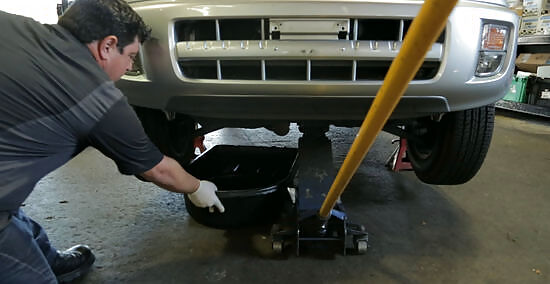
Place the oil drain pan underneath the engine drain plug. Crouch down and look beneath the vehicle. The oil engine drain plug will be located within 1–2 feet (0.30–0.61 m) of the front of the vehicle, and sits directly beneath the engine. It’s on the bottom of a large tank referred to as the oil pan. Slide the drain pan beneath the engine drain plug until it’s centered in place. The oil drain pan should hold at least twice as much oil as your engine takes, so that none of the liquid will spill over the sides of the pan when it’s pouring out of the car.
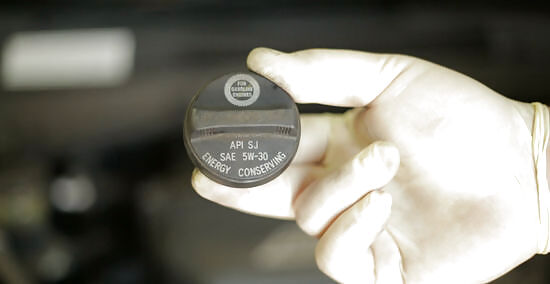
Remove the oil cap by unscrewing it counterclockwise. Open the vehicle’s hood and locate the oil cap on top of the engine. The cap will be about 2 inches (5.1 cm) across and should have an oil symbol (or have the word “oil”) on top. Grasp the cap firmly in 1 hand and twist it counterclockwise to unscrew it. Set the oil cap somewhere nearby where you won’t forget it or lose track of it. Removing the oil cap before you drain the oil will allow the liquid to drain out quickly, since it will have airflow both above and below it.
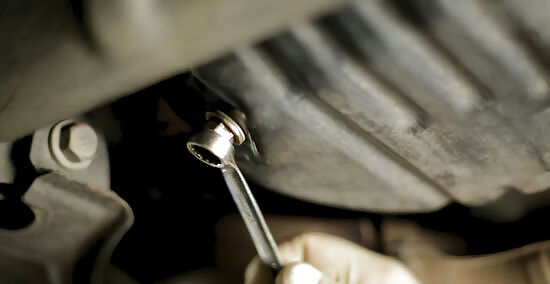
Unscrew the oil plug with a socket or crescent wrench. Loosen the plug counterclockwise using the proper sized socket. If there's enough room to maneuver, you could use a larger crescent wrench. To avoid getting oil all over your arm when removing the drain plug bolt, apply inward force (as if you are trying to push the plug back into the hole) while removing it. When you know that bolt is fully unscrewed, quickly pull it away from the opening. If you’re lucky, only a few drops will get on your hand. You’ll find a metal washer between the oil pan and the drain plug. Remove this as well and set it on the ground next to you.
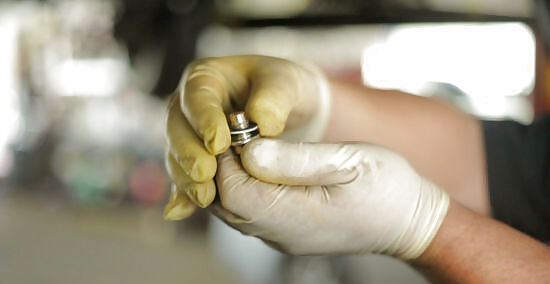
Wait several minutes for all the oil to drain out of the car. Once you’ve opened up the oil pan’s drain plug, the oil will drain out relatively quickly. However, since it’s a thick liquid, it won’t all come out at once. Wait 2–3 minutes to make sure it’s fully drained. When the oil has stopped running out of the crankcase, replace the plug. Put the washer that you removed earlier back in place. Then reinsert the drain plug and tighten it back in the oil pan by turning it clockwise.
Replacing the Oil Filter
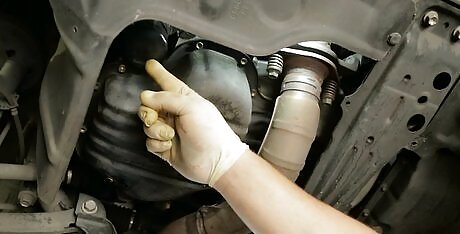
Locate the filter assembly under the vehicle’s hood. Filters are not put in a standard position, so they can be on the front, back or side of the engine depending on the model. Typically, oil filters are white, blue, or black cylinders. They’re about 4–6 inches (10–15 cm) long and 3 inches (7.6 cm) wide, like a big soup can. Look at the replacement filter you purchased to have some idea of what to look for. Some vehicles such as BMWs, Mercedes, and newer Volvos may have a filter element or cartridge as opposed to the simpler spin-on type. They require you to open the cap of a built-in reservoir and lift out the filter element itself.

Twist the oil filter counterclockwise to remove it. First, try by hand to get a good grip and twist slowly and steadily, counterclockwise. If you are unable to remove the filter by hand, you will need an oil filter removal tool to do this. Make sure the drain pan is underneath the filter before fully removing the filter. This will help prevent spillage. Make sure the pan is still under the car catching the spilling oil. There will be some trapped in the filter that will come out when you unscrew it. To avoid spilling too much oil as you remove the filter, you can wrap a plastic bag around the filter, which will catch any oil that escapes as you remove it. Let it sit upside down in the bag to drain as you complete the job.
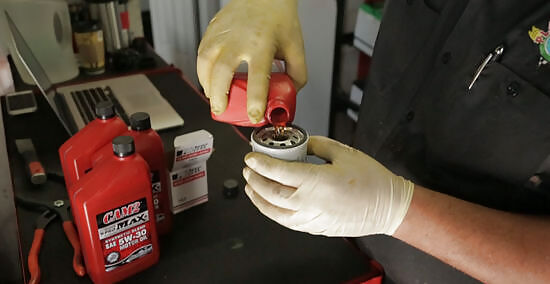
Rub oil on the gasket to prepare the new filter. Dip the tip of 1 finger in the new replacement oil. Smear a thin layer of the new oil onto the gasket ring of the new filter. This will lubricate the gasket and create a good seal for the new filter, and ensure that you’ll be able to get the oil filter off the next time. You can also pour a 20-30 drops of oil into the filter prior to installing it. This will reduce the amount of time your car takes to regain proper oil pressure. If your filter is mounted vertically, you may be able to fill it almost to the top. If it's mounted at an angle, then a small amount of oil will spill just prior to spinning the filter on if you've filled it too full.

Screw the new, lubricated filter carefully into place. Oil filters tend to have delicate threads, so as you turn the filter clockwise to screw it into place, be careful to not cross the threads. In most cases, you’ll tighten the filter until the gasket touches, then a quarter-turn more. Once the filter is in place, you’re ready to add new oil to the engine. The filter will generally say how tight to tighten it; look to the specifications on the box for more specific instructions.
Adding New Oil

Pour new oil into the car at the fill hole. The oil cap should still be off and set safely to the side. Unscrew the top from the oil jug and hold the bottle with the spout on top (facing you). Holding the bottle this way will let the oil pour out more smoothly, without bubbling. Turn the oil jug over in 1 swift motion, and stick the tip of the bottle into the engine’s fill hold. Try to spill as little oil as possible. The amount of oil that you need is in the owner’s manual, usually listed under “capacities.” Make sure you’re adding the correct oil. Typically, you can safely add 10W-30 to most cars in a pinch, but you should consult your owner’s manual or the experts at an auto shop before adding oil.
Replace the fill cap in the engine. Remove the emptied oil jug and screw the fill cap back in the oil fill hold. Turn it clockwise until it’s fully tightened to prevent any oil spillage. Check around for any loose tools you might have left around and close the hood. It’s a good idea to wipe up any spills as best you can, or to rinse off spilled oil with water. Look under the car to make sure nothing is leaking. While it’s not dangerous to get a little oil on the crankcase as you’re pouring, it may smoke as the engine heats up, leading to that burning oil smell that can be momentarily frightening. It can also make your interior smell bad. Feel empowered to change your own oil. "I used to feel intimidated by the idea of changing my own oil. But this article’s straightforward visual walkthrough made the process seem totally doable. Now, I feel confident I can handle this routine maintenance task myself. It’s empowering to gain the skills to properly care for my vehicle." - Kram C. Grasp every step from start to finish. "With clear instructions and photos illustrating each part of the process, I went from knowing nothing about oil changes to understanding exactly what to do. From parking the car to disposing of old oil, this article mapped it out beautifully. I especially appreciated the tips on selecting the right oil." - Kalivaradhan P. Change oil more efficiently, thanks to pro tips. "As a first-timer, the pro tips helped me avoid common mistakes like getting burned by hot oil or stripping the filter threads. Following the advice to lubricate the gasket and remove the fill cap early on, let me complete the oil change faster and more efficiently. Little details like that made a big difference!" - Suzanne E. Maintain your vehicle independently. "I want to take good care of my car but always relied on shops for oil changes. Now, I can handle this routine maintenance myself thanks to the detailed guidance. Doing it myself saves money, and I like knowing exactly what goes into my car. This article empowered me to maintain my vehicle independently." - Mxolisi S. Have a story our readers should hear? Share it with 1 billion+ annual wikiHow users. Tell us your story here.
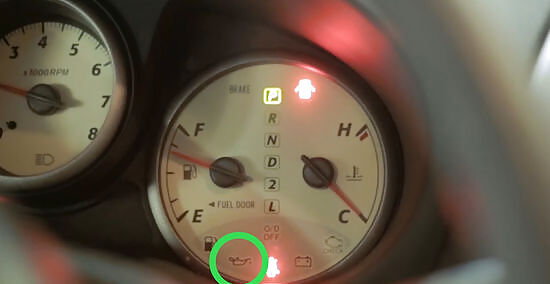
Start the engine and check the oil pressure light. If the “check oil pressure” light is lit after starting up the car, you may not have put in enough oil or some may be leaking out. Leave your car in park or neutral with the parking brake on and look carefully under the car to check for any leaks or drips. If the filter and drain plug aren’t tight, they may leak slowly. Run the engine for a minute or so to get the pressure up and ensure you’ve installed everything correctly. If you spot a leak, turn the engine back off and let it cool for about 10 minutes. Then crawl back under the vehicle and tighten the fill cap underneath the car. This is the most likely spot that oil will leak out from.

Check oil levels by pulling out the dipstick. Once the vehicle has been turned off again and the oil has settled for 5 to 10 minutes, recheck the dipstick to ensure that the levels are where they need to be. If the vehicle is still low on oil, pour in another ounce. Wait another 5 minutes, and check the dipstick again. The dipstick should have markings on it near the end that indicate when the oil level is both “low” and “full.” Different sides of the stick may give levels for both hot and cold oil.
Disposing of Oil
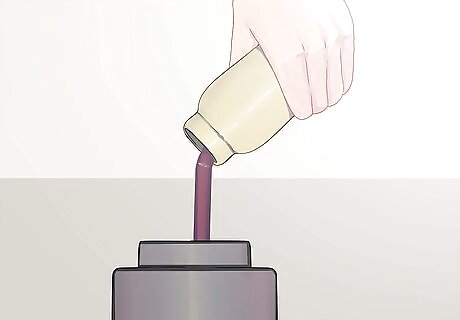
Transfer the oil to a sealable waterproof container. Now that you’ve changed your oil, it’s time to pour the sludgy gunk into a more permanent container. Adding it to the newly emptied oil container you’ve just emptied is the safest bet. Put the tip of a plastic funnel in the bottle and pour the oil slowly to ensure you don’t spill any. Clearly mark the bottle “used engine/motor oil” so you don’t mistake it for the real thing or cooking oil. Other options include old milk jugs, windshield washer-fluid jugs, or other plastic bottles. Be very careful anytime you’re using old food bottles to clearly mark the contents so no mistakes are made. Carelessness here can cause inadvertent consumption or disposal. Don’t put old oil in containers that held chemicals like bleach, pesticides, paint, or antifreeze. These will contaminate the recycling process.
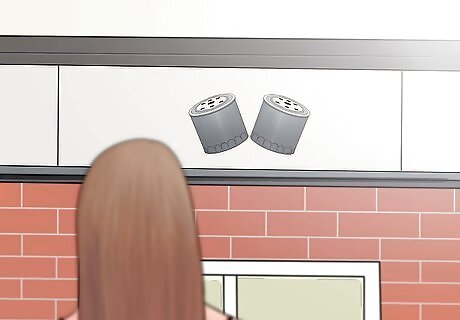
Find a designated oil-collection site near you. Don’t just pour the old motor oil down the drain, and never pour it out on your yard or in the garbage! It needs to be disposed of safely. Typically, all places that sell motor oil will be able to point you towards an oil-collection site. Many service stations that do oil changes will also take your used oil, though sometimes for a small fee. If you need to dispose of the old filter, you can do that at most large automotive suppliers. In some locations, for example, retailers that sell more than 1,000 filters in a year are required to accept old filters. There are also facilities that accept all sorts of hazardous and valuable waste for special disposal, including electronics, scrap metal, and chemicals (e.g. motor oil and paint); research to see if any are in your area.

Try recycled oil the next time your car needs an oil change. Used motor oil is refined until it meets the same certifications and specifications of virgin oil. The process requires less energy than pumping and refining new oil and recycling motor oil helps to reduce the need of foreign oil imported. In some cases, recycled oil also costs less than “new” oil. Next time you’re shopping for oil at a local auto-parts store, ask if they sell recycled oil.


















Comments
0 comment